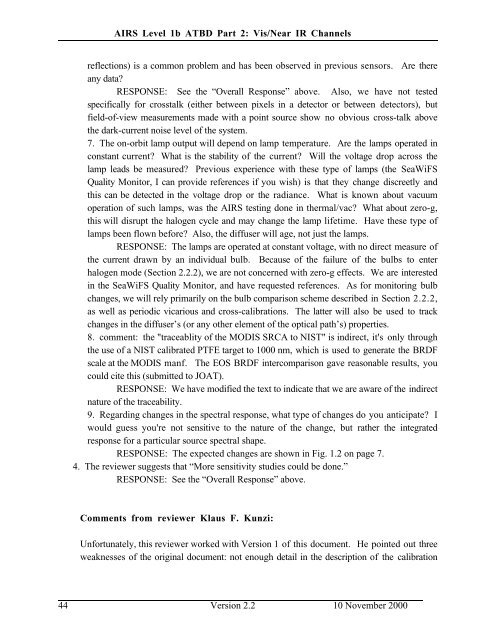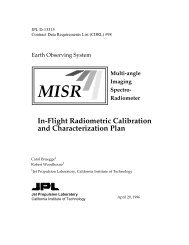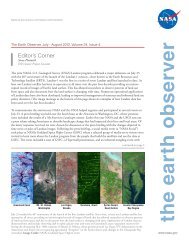AIRS Level 1B Visible/Near-Infrared Channels ATBD - NASA's Earth ...
AIRS Level 1B Visible/Near-Infrared Channels ATBD - NASA's Earth ...
AIRS Level 1B Visible/Near-Infrared Channels ATBD - NASA's Earth ...
You also want an ePaper? Increase the reach of your titles
YUMPU automatically turns print PDFs into web optimized ePapers that Google loves.
<strong>AIRS</strong> <strong>Level</strong> 1b <strong>ATBD</strong> Part 2: Vis/<strong>Near</strong> IR <strong>Channels</strong><br />
reflections) is a common problem and has been observed in previous sensors. Are there<br />
any data?<br />
RESPONSE: See the “Overall Response” above. Also, we have not tested<br />
specifically for crosstalk (either between pixels in a detector or between detectors), but<br />
field-of-view measurements made with a point source show no obvious cross-talk above<br />
the dark-current noise level of the system.<br />
7. The on-orbit lamp output will depend on lamp temperature. Are the lamps operated in<br />
constant current? What is the stability of the current? Will the voltage drop across the<br />
lamp leads be measured? Previous experience with these type of lamps (the SeaWiFS<br />
Quality Monitor, I can provide references if you wish) is that they change discreetly and<br />
this can be detected in the voltage drop or the radiance. What is known about vacuum<br />
operation of such lamps, was the <strong>AIRS</strong> testing done in thermal/vac? What about zero-g,<br />
this will disrupt the halogen cycle and may change the lamp lifetime. Have these type of<br />
lamps been flown before? Also, the diffuser will age, not just the lamps.<br />
RESPONSE: The lamps are operated at constant voltage, with no direct measure of<br />
the current drawn by an individual bulb. Because of the failure of the bulbs to enter<br />
halogen mode (Section 2.2.2), we are not concerned with zero-g effects. We are interested<br />
in the SeaWiFS Quality Monitor, and have requested references. As for monitoring bulb<br />
changes, we will rely primarily on the bulb comparison scheme described in Section 2.2.2,<br />
as well as periodic vicarious and cross-calibrations. The latter will also be used to track<br />
changes in the diffuser’s (or any other element of the optical path’s) properties.<br />
8. comment: the "traceablity of the MODIS SRCA to NIST" is indirect, it's only through<br />
the use of a NIST calibrated PTFE target to 1000 nm, which is used to generate the BRDF<br />
scale at the MODIS manf. The EOS BRDF intercomparison gave reasonable results, you<br />
could cite this (submitted to JOAT).<br />
RESPONSE: We have modified the text to indicate that we are aware of the indirect<br />
nature of the traceability.<br />
9. Regarding changes in the spectral response, what type of changes do you anticipate? I<br />
would guess you're not sensitive to the nature of the change, but rather the integrated<br />
response for a particular source spectral shape.<br />
RESPONSE: The expected changes are shown in Fig. 1.2 on page 7.<br />
4. The reviewer suggests that “More sensitivity studies could be done.”<br />
RESPONSE: See the “Overall Response” above.<br />
Comments from reviewer Klaus F. Kunzi:<br />
Unfortunately, this reviewer worked with Version 1 of this document. He pointed out three<br />
weaknesses of the original document: not enough detail in the description of the calibration<br />
44 Version 2.2 10 November 2000







